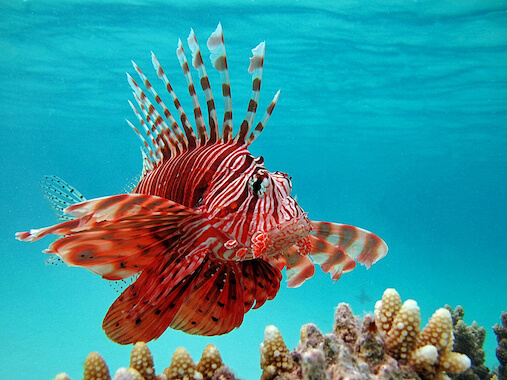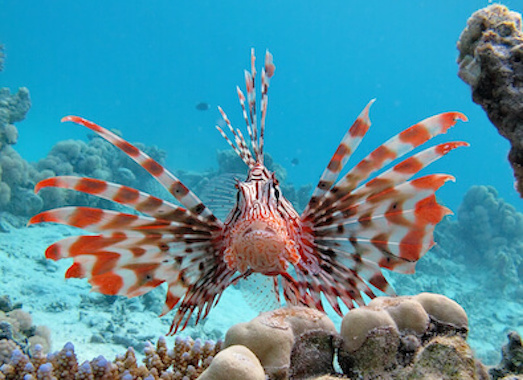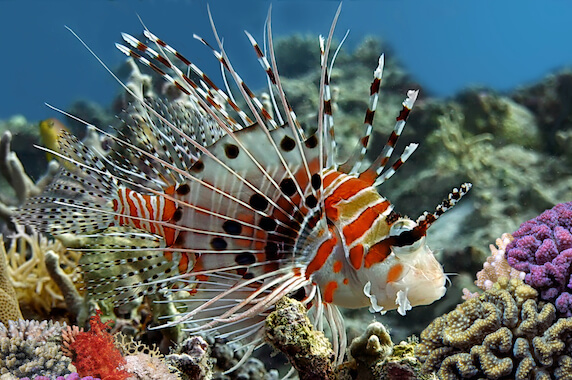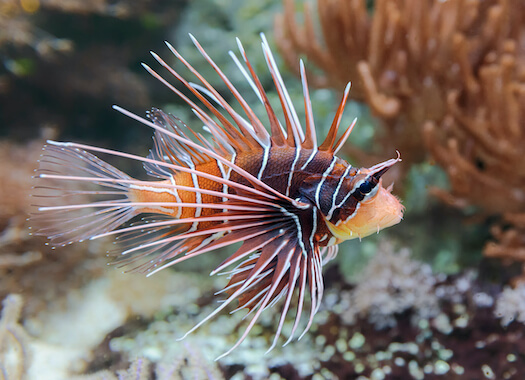
| Kingdom | Animalia |
| Phylum | Chordata |
| Class | Actinopterygii |
| Order | Scorpaeniformes |
| Family | Scorpaenidae |
| Subfamily | Pteroinae |
| Genus | Pterois |
| Species | 12 species |
| Niche | Carnivorous nocturnal venomous fish |
| Length | 8 – 15 inches (20 – 38 cm) |
| Weight | Up to 2.6 lb (1.2 kg) |
| Lifespan | 5 – 15 years |
| Social Structure | Solitary |
| Conservation Status | Least concern |
| Preferred Habitat | Tropical marine waters up to 300 ft (91 m) deep |
| Average Clutch Size | Up to 30,000 eggs |
| Main Food Item | Small fish, molluscs, invertebrates |
| Predators | Eels, groupers, sharks, cornetfish, bobbit worms |
The Basics
The lionfish is a group of 12 species of carnivorous fish native to warm, tropical waters in the Indo-Pacific region. They can be found up to 300 feet (91 meters) deep in a variety of habitats including hard bottom, mangrove, seagrass, coral and artificial reefs created by shipwrecks. Two lionfish species have recently been introduced into the Western Atlantic ocean and Gulf of Mexico, where they are considered to be invasive species.
Lionfish are members of the Scorpaenidae family of scorpionfish, which are characterized by sharp, venomous spines. All 12 species of lionfish have elongated pectoral fins that resemble the mane of a lion when fanned out. In addition to a number of soft fins, lionfish also have 18 needle-like venomous fins on their backs and undersides, which are used for predator defence. Lionfish have conspicuous aposematic warning coloration to alert predators of their venomous nature, exhibiting contrasting red, white, cream, brown or black stripes.

Lionfish reproduce year-round and a single mature female releases around 2 million eggs per year. All 12 lionfish species exhibit similar courtship behaviors in which male and female fish swim around each other in circles or follow one another. Once courtship has ceased, the female releases two buoyant masses of eggs, which are fertilized by the male before floating to the surface. The eggs are initially bound together by an adhesive mucus, however this disintegrates within a few days, at which point individual embryos become free floating.
Hunting and Predation
Lionfish move slowly using their soft dorsal and anal fins to propel them forward. But despite their lack of speed, these fish are skilled hunters thanks to their specialized bilateral swim bladder muscles that allow them to precisely control their buoyancy and therefore their location in the water column. This gives lionfish the ability to adjust their center of gravity as necessary to best attack prey. When attacking, lion fish spread their large pectoral fins and corner their prey against reefs or rocks before swallowing them whole.
Lionfish feed on a variety of prey types including small fish, molluscs and invertebrates such as shrimp. In fact, they have very generalist diets and are known to eat at least 50 different species of fish. Lionfish also have huge appetites and in order to accommodate their large meals, their stomachs can expand up to 30 times their normal size. Although lionfish are nocturnal, they are thought to feed most actively between 7 and 11am. During the rest of day, lionfish might retreat to ledges or crevices amongst rocks or corals.
Despite their venomous nature, lionfish are thought to have a number of natural predators including moray eels, large groupers, nurse sharks, blue spotted cornetfish and bobbit worms. This suggests that some animals might have developed a resistance to lionfish venom, although it is not known how often lionfish are actually eaten by these predators. In addition to inter-specific predation, lionfish are also known to engage in cannibalism, with larger individuals preying upon smaller members of their own species.

Fun Facts about Lionfish
Lionfish have evolved to be both very efficient predators and dangerous prey. These traits have allowed them to become aggressively invasive species, which demonstrate a number of interesting biological concepts.
Invasive Species
Two species of lionfish, the red lionfish and the common lionfish, are found in the Western Atlanic ocean and Gulf of Mexico outside of their native range. Both of these species are considered to be invasive here, although the red lionfish is more common and makes up 93% of the invasive population in the Western Atlantic. Lionfish and other invasive species such as kudzu vine, carp and gray squirrels negatively affect the habitats they have invaded by causing ecological, environmental and sometimes even economic damage. It is thought that red lionfish were first introduced off the eastern coast of Florida in the late 1980’s, perhaps by people that had initially bought them as pets.
Lionfish are prolific breeders and have no natural predators in their introduced range off the east coast of America, which has allowed their population size to increase exponentially since they were first introduced. Due to their large appetites and generalist diets, invasive lionfish have decimated native fish populations in their introduced range, causing prey fish biomass in the Bahamas to fall by 65 – 95% in the 30 years since their invasion. In order to try and bring the lionfish population under control in this region, authorities are encouraging people to catch and eat these fish. It has been suggested that similar action should be taken in Britain, where the invasive gray squirrel has outcompeted and wiped out the native red squirrel across most of its range.
Venomous Fish
Lionfish spines have two glandular grooves extending from the base to three quarters of the way up each spine. Venom is released from the glands when the spines are mechanically disturbed, such as when they enter another animal. Lionfish venom is composed of proteins, the neurotransmitter acetylcholine and a neurotoxin that causes extreme pain, sweating, respiratory distress and even paralysis in humans. Research suggests that lionfish stings are so painful because their venom acts specifically on the nerve cells that are responsible for sensing and relaying pain, implying that the lionfish sting has evolved solely to cause pain.

Venom is used by species from many distantly related animal groups including spiders, snakes, scorpions, jellyfish and sea urchins, conveying that this trait has evolved multiple times throughout evolutionary history. Whilst certain species such as scorpions and snakes primarily use their venom to paralyze their prey, others such as fish and sea urchins use their venom purely for defence against predators. It has been found that venomous fish are often slow moving, as is the lionfish, thus venom in these species perhaps evolved because they are unable to escape from predators by fleeing, so must deter them in another way.
Camouflage
The bold, contrasting stripes of lionfish serve as a conspicuous aposematic warning signal to potential predators that these fish are venomous. However, this is not their only function, as lionfish stripes also provide camouflage when the fish are viewed from a distance by breaking up their outline. In fact, lionfish rely on camouflage to help them sneak up on their prey and even have numerous fleshy growths on their head that are thought to mimic algal growths and disguise their mouths. As well as this, their dark red or brown coloration and their ability to remain almost motionless in the water helps them to blend in with rocks or corals so they can hide from both prey and predators.
